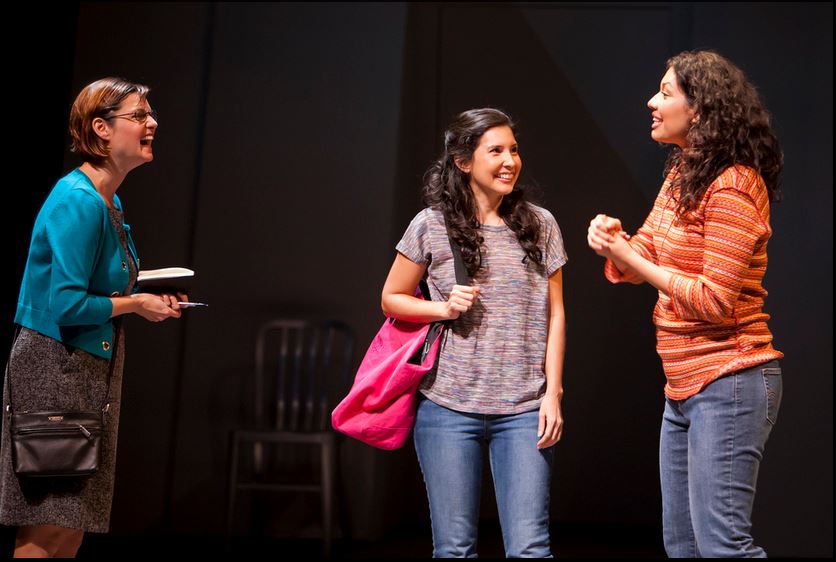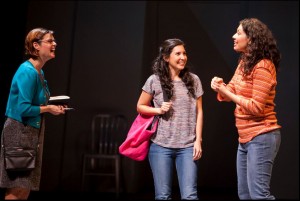
22 Oct Tall Tales: “Just Like Us” at Denver Center
Editor’s note: Telluride Inside… and Out’s monthly (more or less) column, Tall Tales, is so named because contributor Mark Stevens is one long drink of water. He is also long on talent. Mark is the author of two Colorado-based mysteries, “Antler Dust” and “Buried by the Roan,” both on the shelves of Telluride’s own Between the Covers Bookstore, 224 West Colorado Ave, Box 2129. (The third book in the series, “Trapline” is due to be released in Fall, 2014). Mark is a former reporter (Denver Post, Christian Science Monitor, Rocky Mountain News) and television producer (MacNeil/Lehrer NewsHour), now working in public relations. He also now writes theatre reviews for TIO, such as the one that follows, “Just Like Us,” based on a book by Helen Thorpe, up through November 3.

Mary Bacon, Adriana Gaviria and Cynthia Bastidas in the Denver Center Theatre Company’s world premiere production of “Just Like Us,” by Jennifer M Koskinen
Helen Thorpe’s non-fiction work “Just Like Us” offered an intimate portrait of the immigration issue from the real-world streets of Denver. Thorpe chiseled humanity into an issue known for its hot air and vitriol. Her book showed in a powerful way how the fates of four Hispanic female high schoolers, all who dreamed of going to college, hinged on so many elements outside their control.
Two of the young women had no path to citizenship at the time Thorpe gathered information for the book. A third had legal status. The fourth acquired a green card while in high school. Despite their varying statuses, the four were tight friends and rooted for each other’s dreams. Running in and out of the shadows of authority, the four emerged in Thorpe’s book as “hybrid creatures” who straddled legitimate society and underground cultures.
But the book’s layers and intricacies also grew out of Thorpe’s entanglement in the issue itself. At the time she was researching it, Thorpe’s husband, then-mayor John Hickenlooper, was dragged into the middle of the immigration firestorm. The inciting incident was when an international manhunt was launched for an employee at one of his restaurants. The employee was wanted in connection with the murder of a Denver police officer and the employee had faked his identification papers. In the book, Thorpe writes in a blunt and honest manner about her relationship with these gripping, tragic events. In the end, it’s hard to read Just Like Us and think that the immigration issue is one that can be rendered in stark black-and white terms.
Just Like Us, the book, is nuanced and subtle. I reviewed it at the time it was published: http://wp.me/plqD1-4h I’ll repeat here: Helen Thorpe is a friend.
Unfortunately, the adapted play based on the book doesn’t work as well. If you’re unfamiliar with the particulars of the story, the play now running at Denver Center Theater offers a compressed recap of the storyline. That’s not a bad thing; there are some gripping and life-stranger-than-fiction moments.
But the play lacks tension. In part, that’s because it hits one overarching note of sympathy for the four young women. The play asserts from the get-go that they are smart, hard-working and deserve to go college. But they aren’t in control of their destiny. They are not in a position to enact a plan. As a result, they are at the mercy of the political landscape. The antagonist is diffused and vague. They want to climb a mountain, but which one? And how?
The theatrical version of “Just Like Us” slips into an episodic chronicle of events. That the girls have worked hard to keep their grades up is great, but then various benefactors arrive to save the day in somewhat random fashion (as in real life) and through no particular effort on the part of the students themselves.
The book was a work of anthropology as much as journalism. Thorpe spent years embedded with the foursome and the moments when she decides to “get involved” could have provided the internal struggle that could have served as the focus for the play (though Thorpe likely would not have wanted the focus of the play on her role.) The basic arc and structure that make for a good story (beginning, middle and end) don’t exist here. Why should it? Why would it?
That said, the play is colorful and the writing here is crisp. Playwright Karen Zacarias did a commendable job of condensing the story’s essence. Director Kent Thompson keeps the scenes flying. He has a lot of ground to cover and does it well, shifting from dorm room to dance club and a whole variety of settings with ease, enhanced by powerful photographs to add backdrop. To underscore Thorpe’s ongoing presence, actress Mary Bacon is asked to sit at the side of the stage and take notes or observe passively. It’s a bit of a thankless role. Thorpe in the play fills in the blanks that the actors can’t handle, although some of observations are heavy-handed and Thorpe’s big revelation, at least as the play imagines it, doesn’t seem like a world-shattering moment, just another realization as a reporter goes about her work.
The four principle actresses (Yunuen Pardo as Marisela; Adriana Gaviria as Yadira; Cynthia Bastidas as Clara and Ruth Livier as Elissa) deliver engaging, spirited performances. We are fully convinced they are real pals. Again, however, as a quartet of protagonists, the focus grows diffuse. (One of the four disappears in the second act; off to college in another state.)
The story is heavily populated with parents, roommates, boyfriends, widows, politicians, teachers, politicians, activists and siblings. An ensemble cast—it seems like everyone gets a chance to play a half-dozen characters—gives Just Like Us ample energy (though you may be confused to see an actor play one of the girl’s monolingual Spanish-speaking parents and, a few minutes later, the anti-immigration zealot Tom Tancredo).
The treatment of Tancredo offers a mini snapshot of how the book and the play diverge. In the book, Thorpe drives around Denver with the well-known politician and we see the feisty conservative in more relaxed, humane light. In the play, Tancredo is relegated to a nearly cartoon level, a one-note immigrant basher. We are meant to see nothing but his bombast.
The book took pains to provide a three-dimensional view of an issue often reduced to thin talking points. The book allowed us to decide how to viewed the plights of these four women. The play, at least for me, flattened the book back down. I left with the feeling that I was being told what to think and how to view this complex, tricky issue.


Sorry, the comment form is closed at this time.